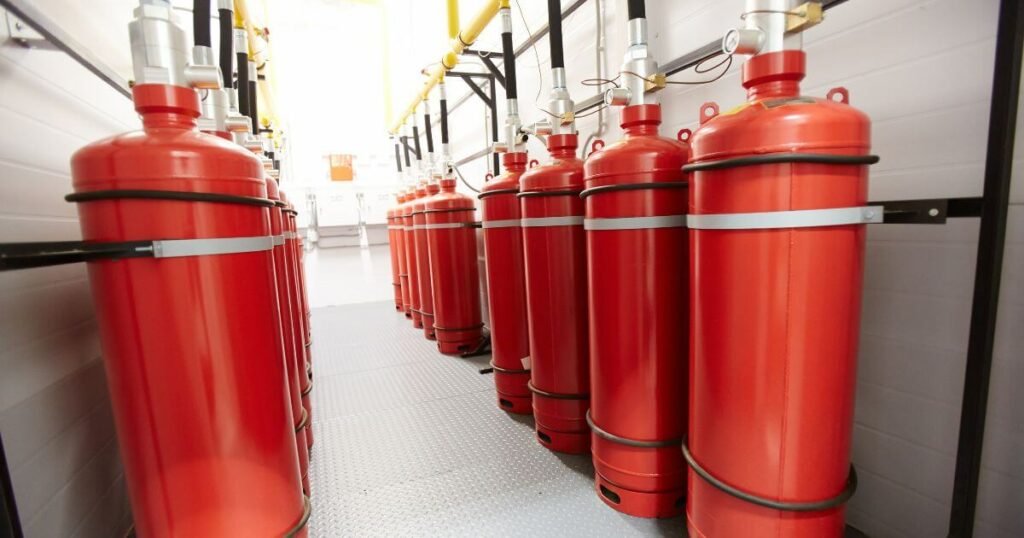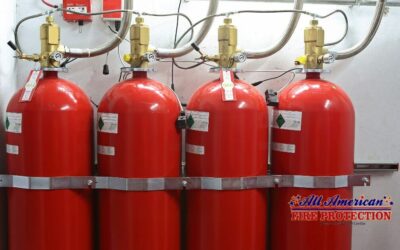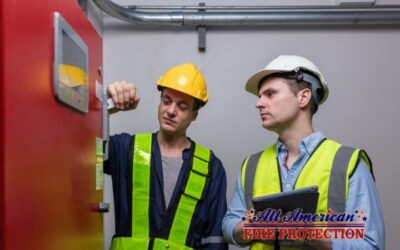Foam fire suppression systems might not grab headlines like their more traditional firefighting counterparts, but they hold a unique position in the arsenal against fires that cannot be quelled by water alone. Their remarkable effectiveness and versatility set them apart in the broad spectrum of fire suppression methods, marking them as crucial techniques in their own right. At All American Fire Protection, we specialize in providing trusted fire suppression systems in Spring Lake, North Carolina, including advanced foam solutions.
The main categories of firefighting foam solutions include Aqueous Film Forming Foam (AFFF), Alcohol-resistant Aqueous Film-Forming Foams (AR-AFFF), Protein foams, and Synthetic foams, each celebrated for their specialized applications. Single Grain firefighting foam, though less common, offers a nuanced but powerful option for tackling specific types of fires.
Delving deeper, each kind of firefighting foam brings its own flavor of benefits, from the chemistry behind its fire-suppressing capabilities to the unique environmental considerations it necessitates. The subsequent sections will unfold these layers, providing a more profound appreciation of how firefighting foam suppression stands as an indispensable ally in the fight against fires, safeguarding both natural and man-made environments across the globe.
Trust All American Fire Protection for reliable and comprehensive fire suppression systems, ensuring your safety with our expertise in foam fire suppression methods.
What is foam fire suppression system?
Firefighting foam suppression is a method that employs a specialized foam to extinguish fires, especially those that water alone cannot tackle. This foam operates by forming a barrier between the fire’s fuel and the air, effectively cutting off the oxygen that fuels the fire. It also cools down the fire and prevents the release of flammable vapors that could reignite.
There are several types of firefighting foams, each designed for specific kinds of fires, such as those involving hydrocarbons or polar solvents. This method is widely used in various scenarios, including aircraft fires, flammable liquid fires, and even in creating firebreaks in wildland fires. Understanding how firefighting foam suppression works and its applications is crucial for effectively managing and extinguishing challenging fires.

How does firefighting foam work?
Firefighting foam operates through a trio of critical mechanisms: cooling the fuel, separating the fuel from oxygen, and preventing vapors from rising and igniting. By cooling, it brings the fuel’s temperature below its ignition point, effectively reducing the fire’s intensity. The foam’s barrier-like presence separates the fuel from oxygen, starving the fire of one of its essential elements.
Additionally, this layer prevents the escape of flammable vapors, thwarting potential re-ignition. Through these strategic actions, firefighting foam proves to be an effective tool in suppressing and extinguishing fires, especially those involving flammable liquids or hazardous materials, by tackling the fire on multiple fronts. For instance, during the 2015 industrial fire in California, AFFF was deployed to combat a massive blaze involving hydrocarbon storage.
The foam’s cooling effect was immediately noticeable, significantly reducing the fire’s intensity within minutes. Its barrier effect prevented oxygen from reaching the fuel source, effectively suffocating the fire. Moreover, the foam’s vapor-suppressing quality was crucial in preventing the ignition of adjacent volatile substances, showcasing its comprehensive fire suppression capabilities.
Suppressing fire by cooling the fuel
Firefighting foam reduces the temperature of the fuel, rendering it too cool to sustain combustion. This action diminishes the fire’s intensity and decelerates its expansion. A notable example includes the 2018 refinery fire in Texas, where protein foam was applied, cooling down the fuel to a point where the fire could be safely managed and eventually extinguished.
Separating the fuel from the oxygen
The foam establishes a physical barrier between the fuel and the surrounding air. By blocking oxygen access to the fuel, it effectively suffocates the fire, hindering its ability to continue burning. This mechanism was pivotal in the 2017 chemical plant fire in Louisiana, where AR- AFFF foams was used to isolate and suppress a volatile solvent fire, preventing it from spreading to adjacent tanks.
Preventing vapors from rising and igniting
Foam coverage inhibits the release of flammable vapors, preventing them from mixing with air and igniting. This crucial step significantly lowers the risk of re-ignition, contributing to the overall suppression effort. The 2019 dockside fire in New Jersey demonstrated the effectiveness of synthetic foam in creating a vapor-suppressing blanket over a large area, preventing the fire from reigniting and facilitating safe firefighting operations.
Types of foam to extinguish a fire
The firefighting arsenal includes a variety of foams, each designed to address specific fire scenarios. Below is a detailed table outlining the types of firefighting foams, their applications, and examples of use cases:
| Foam Type | Application | Use Case Examples | Unique Properties or Advantages |
|---|---|---|---|
| AFFF | Hydrocarbon fires (e.g., petrol, diesel) | Used in airport fire services and oil refinery fires | Forms a barrier that blocks oxygen and prevents vapor release, quick sealing capability |
| AR-AFFF | Polar solvent fuel fires (e.g., alcohols, ketones) | Deployed in chemical plant incidents and fuel tanker accidents | Adds a protective layer over the fuel, effective on water-miscible substances |
| Protein foams | Prolonged firefighting efforts | Used in forest fire containment and structural fires | Creates a stable, heat-resistant blanket, good for long-lasting barrier formation |
| Synthetic foams | Large area fires | Employed in warehouse fires and large-scale spill incidents | High expansion ratios, covers large areas swiftly, ideal for quick spread control |
Aqueous Film Forming Foam (AFFF)
AFFF excels in combating hydrocarbon fuel fires, deploying a film that efficiently isolates the fuel from oxygen, thereby smothering the blaze. Notable use includes extinguishing large-scale fires at airports and oil refineries, where its rapid deployment and spreading capability can quickly bring fires under control.
Alcohol-resistant Aqueous Film Forming Foams (AR-AFFF)
AR-AFFF is tailored for polar solvent fuel fires, including combustible liquids, by laying down a protective layer that blocks the fuel from igniting. It has been pivotal in incidents such as chemical plant fires and fuel tanker accidents, offering a specialized solution where traditional foams might fail.
Class B Foam: Protein Foams
Protein foams generate a stable, heat-resistant blanket that suffocates the fire, while also insulating it to prevent any potential re-ignition. Their use in forest fire containment efforts and for protecting structures during prolonged firefighting operations demonstrates their effectiveness in creating long-lasting barriers against fire.
Class A Foam: Synthetic Foams
Synthetic foams have an expansion ratio that is higher and can swiftly envelop large areas, making them ideal for tackling extensive fire outbreaks such as warehouse fires or large-scale spill incidents. Their ability to cover vast areas quickly and with less product makes them a cost-effective option for large-scale fire suppression.
Applications of firefighting foam
Firefighting foam is a versatile tool in combatting various types of fires, with applications that span across different environments and scenarios. Its effectiveness is particularly notable in aircraft fires, where rapid suppression is crucial for ensuring safety. In the case of flammable liquid fires, such as those involving storage tanks and spills, firefighting foam excels by creating a barrier that prevents further spread.
Additionally, its utility extends to wildland fires, where it is employed to construct firebreaks that effectively halt the advance of flames. Each application capitalizes on the foam’s unique capabilities to form a barrier between the fuel and oxygen, cool down the fire, and prevent the release of flammable vapors, showcasing its indispensable role in a broad range of firefighting efforts.
| Application Scenario | Description | Notable Example |
|---|---|---|
| Aircraft fires | Firefighting foam plays a critical role in extinguishing fires on aircraft, where rapid action is essential for the safety of passengers and crew. | The use of AFFF in the 1988 Ramstein Air Base disaster significantly reduced the fire damage and potential casualties. |
| Rapid suppression needed for safety | The foam’s quick-acting suppression capabilities are crucial, minimizing damage and safeguarding lives during aircraft fire emergencies. | During the 2013 San Francisco Airport crash, firefighting foam was pivotal in controlling the fire, allowing more passengers to evacuate safely. |
| Flammable liquid fires | Foam is particularly effective against liquid fuel fires, such as those involving fuel or chemicals, by creating a barrier that isolates the fuel from oxygen. | The 2005 Buncefield fire in the UK saw a massive deployment of AR-AFFF to combat one of the largest fires in peacetime Europe. |
| Storage tanks and spill fires | In incidents involving storage tanks or spills, firefighting foam quickly covers the area, smothering flames and mitigating environmental impact. | The 2010 Deepwater Horizon oil spill utilized firefighting foam extensively to prevent the spread of fire on the water’s surface. |
| Wildland fires | For wildland fires, firefighting foam is strategically deployed to construct firebreaks, significantly slowing the fire’s spread and protecting untouched land. | The use of firefighting foam in the 2018 California wildfires helped in creating effective firebreaks, saving numerous structures and natural areas. |
| Used to create firebreaks | Utilizing foam concentrate to form barriers enables firefighters to control the direction and extent of large-scale fires, proving it to be an indispensable strategy in wildland fire management. | In the 2019 Amazon rainforest fires, firefighting foam was used to protect vulnerable areas and limit the fire’s spread. |
Each application showcases the indispensable role of fire fighting foam in a broad range of firefighting efforts, from rapid suppression in aircraft emergencies to strategic containment in wildland fires. The examples provided illustrate the foam’s versatility and effectiveness in real-world scenarios, emphasizing its critical contribution to safety and fire management.
Environmental impacts of firefighting foams
While firefighting foams play a crucial role in extinguishing fires, their use comes with significant environmental implications. These substances can lead to the contamination of groundwater, posing a risk to water sources and the broader environment. Additionally, they contribute to the accumulation of persistent organic pollutants (POPs), which can remain in the ecosystem for extended periods, causing long-term damage.
The toxicity to aquatic life is another pressing concern, as the chemicals within the foam can disrupt aquatic ecosystems and harm wildlife. Moreover, certain components of firefighting foams have been identified as harmful to the ecosystem, necessitating a careful consideration of their use and the development of strategies to mitigate their environmental impact. Balancing the immediate firefighting benefits of these foams with the imperative for environmental preservation is essential for sustainable firefighting practices.
Contamination of groundwater
Firefighting foams, when used extensively, can seep into the soil, leading to the contamination of groundwater. This contamination poses significant risks to drinking water sources and the broader environmental health.
Persistent organic pollutants (POPs)
Some firefighting foams contain chemicals that are classified as POPs, which are known for their long-lasting presence in the environment. These pollutants can disrupt ecosystems and pose health risks over time.
Toxicity to aquatic life
The chemical components found in certain firefighting foams can be highly toxic to aquatic organisms, threatening the balance and viability of aquatic ecosystems.
Harmful chemicals affecting ecosystems
Beyond aquatic environments, the chemicals in firefighting foams can have broader ecological impacts, affecting terrestrial organisms, plants, and the overall health of ecosystems.
Detailed Environmental Impact Table
| Environmental Impact | Chemicals of Concern | Effects | Case Studies/Research Findings |
|---|---|---|---|
| Groundwater Contamination | PFAS (Per- and polyfluoroalkyl substances) | Long-term water source contamination, health risks to humans and wildlife | Studies have shown PFAS contamination in groundwater near military bases and airports where AFFF is used. |
| Persistent Organic Pollutants (POPs) | PFOS (Perfluorooctanesulfonic acid), PFOA (Perfluorooctanoic acid) | Bioaccumulation, potential carcinogenic effects, disruption of endocrine systems | Research indicates PFOS and PFOA, once common in firefighting foams, persist in the environment and accumulate in the food chain. |
| Toxicity to Aquatic Life | Fluorinated surfactants | Disruption of reproductive systems, mortality in fish and aquatic invertebrates | Studies have documented the acute toxicity of firefighting foam runoff in streams and rivers, leading to fish kills. |
| Harmful Chemicals Affecting Ecosystems | Heavy metals, fluorinated surfactants | Soil contamination, bioaccumulation, harm to terrestrial and aquatic organisms | Investigations have found elevated levels of heavy metals in areas frequently exposed to firefighting foams, impacting local flora and fauna. |

How are firefighting foams applied?
The application of firefighting foams is strategically chosen to match the specific fire scenario, employing techniques that ensure efficient and effective suppression. Direct application sees the foam being sprayed directly onto the fire, targeting the base of the flames for quick suppression. Indirect application involves applying the foam to adjacent areas or surfaces, not directly on the fire, to prevent the spread of flames.
Another approach, Compressed Air Foam Systems (CAFS), mixes the foam with air, producing a more expansive and adhesive foam blanket that covers larger areas more effectively, offering better penetration and coverage. Each method is selected based on the fire’s characteristics, optimizing the firefighting efforts for the best possible outcome.
Direct application
Foam is discharged directly onto the fire, targeting the base of the flames for immediate suppression and extinguishment. This method is particularly effective for quickly controlling and extinguishing localized fires, such as those involving vehicles or small structures. Equipment used includes foam nozzles and monitors that allow firefighters to adjust the flow and spread of the foam accurately.
Example: In a vehicle fire at a fuel station, firefighters might use direct application to quickly cover the burning vehicle and adjacent fuel pumps with foam, preventing the fire from spreading.
Foam applied directly onto the fire
This method ensures the foam directly interacts with the fire, providing rapid suppression and cooling. The direct approach allows for targeted application, minimizing foam usage while maximizing the suppression effect.
Indirect application
Foam is applied to surfaces or areas adjacent to the fire, not directly on it, to create a preventive barrier that stops the fire from spreading. This technique is useful in large-scale incidents, such as warehouse fires, where preventing the fire’s spread is critical. Indirect application can be achieved using foam branches, hoses, and fixed fire suppression system.
Example: During a warehouse fire involving flammable liquids, fire fighters might use indirect application to coat the surrounding areas, creating a foam barrier that contains the fire to the initial area of ignition.
Foam applied to adjacent areas to prevent spread
This technique safeguards uninvolved areas, effectively containing the fire and minimizing its potential growth. It’s particularly useful in scenarios where direct access to the fire is challenging or dangerous.
CAFS (Compressed Air Foam Systems)
CAFS mixes foam with air, resulting in a foam with a higher expansion ratio, enabling it to cover larger areas more efficiently. This system is highly effective for both direct and indirect applications, offering deep penetration and lasting suppression. CAFS can be deployed from fire trucks equipped with the system, providing a versatile response to various fire types.
Example: In a wildland fire scenario, CAFS can be used to lay down a thick, adhesive foam blanket over the vegetation, creating firebreaks and suppressing hotspots without the need for extensive water resources.
Foam mixed with air for better coverage
This approach enhances the foam’s adhesiveness and penetration, significantly improving its firefighting effectiveness. The expanded foam adheres to surfaces, providing a durable barrier against the fire and reducing the risk of reignition.
Safety considerations when using firefighting foam
When deploying firefighting foam, prioritizing safety is crucial. Personal protective equipment (PPE), such as full facepiece respirators, gloves, and protective suits, is essential to shield firefighters from harmful chemical exposures. Equally critical is the proper training and handling of the foam, ensuring that firefighters are well-versed in its properties and the most effective application techniques for different fire scenarios.
Additionally, the disposal of foam residues must adhere to strict environmental guidelines to mitigate contamination risks and protect the ecosystem. These safety protocols are vital not only for the direct protection of firefighting personnel but also for minimizing the environmental footprint of firefighting efforts, underscoring the importance of comprehensive safety measures in the use of firefighting foam.
Personal Protective Equipment (PPE) Recommendations
| Foam Type/Application | Recommended PPE | Purpose/Protection Offered |
|---|---|---|
| AFFF & AR-AFFF | Full facepiece respirators, gloves, protective suits | Protects against chemical exposure from hydrocarbons and polar solvents |
| Protein Foams | Gloves, protective suits | Shields from heat and potential irritants |
| Synthetic Foams | Full facepiece respirators, gloves | Prevents inhalation of chemical vapors and skin contact |
| General Use | Eye protection, gloves, protective footwear | Basic protection during foam handling and application |
Training and Handling Guidelines
| Aspect | Guidelines | Details |
|---|---|---|
| Training | Regularly scheduled training sessions | Ensure firefighters are familiar with foam properties, application techniques, and safety measures |
| Handling | Follow manufacturer’s instructions | Proper mixing, application, and storage of firefighting foams |
| Scenario-based Training | Simulated fire scenarios | Practice using different foam types in controlled environments to prepare for real-life fires |
Disposal of Foam Residues and Environmental Guidelines
| Procedure | Guidelines | Environmental Consideration |
|---|---|---|
| Foam Residue Disposal | Adhere to local environmental regulations | Prevent groundwater contamination and protect wildlife |
| Cleanup | Use containment methods for foam and water runoff | Minimize environmental impact and prevent spread to waterways |
| Reporting | Report significant spills to environmental authorities | Ensure proper oversight and mitigation of potential environmental damage |
All American Fire Protection: Addressing PFOA and PFSA Concerns for Firefighters
Firefighting foam is a vital tool in the battle against flames, thanks to its unique properties that allow it to quickly and effectively extinguish fires. By lowering the surface tension of water, foam stabilizers enable the creation of a thick, clinging foam blanket that smothers the fire and prevents reignition. Efficient fire control is achieved through the use of specialized foams like AFFF (Aqueous Film-Forming Foam) and FFFP (Film-Forming Fluoroprotein) foam, which are designed to rapidly extinguish the fire and prevent it from spreading. As a leading provider of fire protection solutions, All American Fire Protection recognizes the critical role that firefighting foam plays in safeguarding lives and property. By offering a wide range of high-quality firefighting foams and expert guidance on their application, All American Fire Protection is committed to helping businesses and communities stay prepared and protected in the face of fire emergencies.
FAQs
1. What is firefighting foam and how is it used in fire suppression?
Firefighting foam is a specialized suppression agent used to suppress fires by creating a foam blanket that seals off the fuel source and prevents oxygen from reaching the fire.
2. What are PFAS and why are they a concern in firefighting foam?
PFAS, or per- and polyfluoroalkyl substances, are synthetic chemicals used in foam concentrate to make them more effective in fighting flammable liquid fires. However, PFAS are a concern due to their persistence in the environment and potential health risks.
3. What are fluorine-free fire fighting methods and how do they compare to PFAS-containing foams?
Fluorine-free foams are firefighting solutions that do not contain PFAS or other fluorinated compounds. They offer an alternative to PFAS-containing firefighting foams, with a focus on environmental sustainability and health safety.
4. How do AFFF and AR-AFFF differ in terms of firefighting effectiveness?
AFFF and AR-AFFF are two types of foam used for fire suppression. AR-AFFF is specially formulated to combat fires involving flammable liquids like alcohol, providing enhanced effectiveness compared to traditional AFFF.
5. What is the role of PFAS in aqueous film forming foams (AFFF) and how can it impact the environment?
PFAS-containing suppression foams like AFFF utilize PFAS to create a stable vapor-suppressing foam. However, the use of PFAS in these foams has raised concerns about environmental contamination and its long-term effects on ecosystems.







